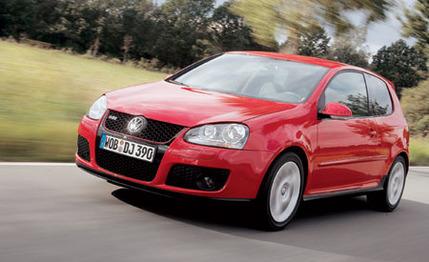 First Drive Review
First Drive Review
The year 1983 was a rockin' one in America. Michael Jackson, at the time a black man, dazzled us with his float-on-the-floor moonwalk. Jennifer Beals donned leg warmers and a cut-up sweatshirt in the chick-flick Flashdance. Quiet Riot's Metal Health became the first heavy-metal album to top the pop charts. Could '83 have been more revolutionary?
Well, common sense would say impossible. Then again, there was nothing common about 1983. Take the automotive landscape, in which the sporty arena, littered with Chevy Camaro Z-28s and Datsun 280ZXs, got a startling wake-up call from the most unassuming alarm clock, the Volkswagen GTI.
Volkswagen's recipe for the GTI was simple: Take the lightweight Rabbit econobox and deck it out with black trim, red "GTI" badges, and a smart interior. Then give it a gutsy 90-hp, 1.8-liter four and a taut Teutonic suspension and-- ring the dinner bell!--America's original pocket rocket was served up for about eight grand, thousands less than more brutish but often slower sports cars. We sampled the '83 GTI in November 1982 ["FYI"] and came away infatuated--"the car we've all been waiting for."
Twenty-two years have slipped away since then, and "waiting" is exactly what Volkswagen expects of us, again. According to VW of America, we won't see the fifth-generation GTI shown here for about a year. Of course, the outlook could be worse--the car could, you know, stink. But let us be the first to unequivocally dispel that rumor. Based on our preview drive of the car in Europe, which spanned over eight hours in German and French countryside, we can say without reservation that the new GTI once again sets the bar.

When asked what contemporary vehicle VW benchmarked, director of product planning Charlie Waterhouse told us, "Actually, we benchmarked the original GTI, the Mark I." Introduced in Europe in 1976, that first-generation Mark I (the U.S. "original" '83 GTI was a second generation), with its frisky legs, would cause someone to apply the term "pocket rocket" to a car. So, more important than eclipsing today's best hatchbacks, VW's goal with this redone GTI was to recapture the essence of the original. In other words, build a quick, aggressive three-door with a pure, sporty character. "A wolf in sheep's clothing," said Len Hunt, VWoA vice-president of sales and marketing.
We wouldn't say it wears sheep's threads, but we can certainly confirm that the new GTI is hiding a wolf. To chase down road game, the GTI utilizes a feisty 2.0-liter four-cylinder featuring direct injection and a single turbocharger. Essentially the same technology used by Audi in its R8 race cars, the GTI's one-two punch of direct injection and turbocharger creates a powerplant that is fuel efficient, highly responsive, and most important, powerful. With a relatively high compression ratio of 10.5:1, the GTI's heart pumps out 197 horsepower at 5100 rpm and 207 pound-feet of torque at just 1800. Power delivery is silky smooth and instantaneous, leading us to suspect VW had planted a VR6 under the hood. Turbo lag? Zilch. The GTI's horses never rest, always at your beck and call.
Should you want to beck and call the GTI to 60 mph, it'll take about seven seconds with the standard six-speed manual, according to VW, and a few 10ths less with the optional six-speed DSG automated manual. Our test car had the standard six-speed--a unit characterized by short, direct throws and a light clutch--and felt especially sprightly, inclining us to believe it will perform in the neighborhood of the last GTI 1.8T we tested [ C/D, March 2002], which hit 60 in 6.5.
Volkswagen says the new GTI's static body rigidity is up 80 percent, thanks to more high-strength-steel body panels and 230 feet of laser-welded seams (versus 16 feet in the current car). Increased body rigidity equates to added response from the suspension--a four-wheel independent setup with struts up front and a fresh multilink design in back--which in turn equals heavy doses of epinephrine. Sitting 0.6 inch lower than the fifth-generation Golf on which it is based, the GTI begs to be thrown into and out of corners, its linear steering and beefy four-wheel disc brakes pushing the standard 225/45R-17 tires to limits never thought possible in the old car. As it should be, the ride is two parts firm, one part compliant--a ratio we surmise becomes more unyielding with the optional 40-series 18s.
Inside, the new GTI pays homage to the original with an all-black headliner, plaid-cloth seat inserts, and a three-spoke steering wheel. Modern touches include brushed-aluminum pedals, aluminum-framed gauges, six airbags, and myriad electronic features, notably, automatic climate control, an in-dash six-CD changer, and an optional navigation system.
Retro cues carry over outside as well, where this new GTI gets a black honeycomb grille with a red frame strip and GTI badge, blacked-out trim and sill extensions, and darkened headlight assemblies, which house standard-equipment xenon bulbs. Red-painted brake calipers add some flair, as does the racy wedge-like design, which belies the perception that the new GTI is smaller than its forebear. Indeed, the fifth generation rides on a 2.6-inch-longer wheelbase and is up about an inch in length, width, and height.
Volkswagen hopes to sell some 15,000 GTIs a year, priced "several thousand less" than the estimated $25,000 tab for the Audi A3, which shares the GTI's architecture and 2.0-liter powertrain. If Volkswagen can deliver on that bottom line, then many of the hip Gen Xers from '83 might be fighting today's sport-compact junkies for spots on the waiting list.